Some hospitals will avoid performing the proper tests which can prove this type of damage and will suggest that they have no explanation.
However an honest ophthalmologist will admit that all the effects reported here can be caused by damage to the brain, optic nerve and the autonomic nervous system.
Patches in the vision - Many people who have been exposed to Organophosphates find that they suffer with dim areas within the visual field, almost like a shadow in places. One lady whose husband used OP insecticides in their home every year described these "patches" as "like coffee stains on the paper". Sometimes more of the patches will show if the background is not white. Perhaps reflected light is too bright from a white area but pastel shades show the patches as areas of "shadow",
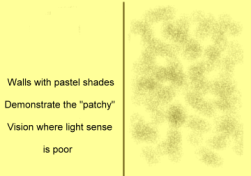
This was what the test proved but they had to use a red filter and a manual testing system. Several lights go on at the same time and you have to tell the operator where they were in the visual field. If the light isn't seen then they make it brighter later and test again. Automatic testing doesn't find this problem as the subject has to describe how many of the lights are seen and at which point in the visual field they were at each stage.
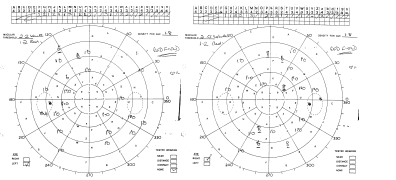
Some have described this as like trying to see through a bundle of drinking straws when some of them are blocked. The brain seems to try to complete a recognisable picture from the inadequate information received from the eyes through the nerves and the result is -
Distorted images - the effects can be seen by following parallel vertical or horizontal lines and noting what happens. Try each eye on its own and spot the difference.

Those affected may well discover when they view the eye charts at their opticians that they see effects similar to those depicted below. In this case experienced by an occupationally exposed farm worker who actually had some diluted insecticide drip into his right eye and was then poisoned by an illegal mix of insecticides some years later.

Image retention - This is also known as "Visual Perseveration" and can lead the brain to be confused as to what it is actually seeing.
The brain does not clear the previous image and it is imposed on the current view
giving the impression of "ghosting", double, or even treble vision.
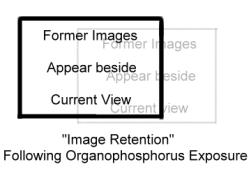
Image retention may also explain how colours appear to change. A good test for this is to ask someone to pass a white hand or cloth across a red or green background.
It will produce an interesting effect.
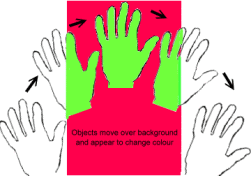
Hypersensitivity to light - "Photophobia" a known effect of anticholinesterase compounds.
Could this be the result of the image retention problem as the brain tries subconsciously to avoid the light which it knows will block areas of vision for some time?
Even the small decorative lights used at Christmas can cause discomfort. Many have to wear dark glasses and eye shields to watch television or sit in well-lit rooms.
Even the words in the credits of films can "glare", especially white text on a black or dark background, making it impossible to read text.

Pupil size. It is known that one of the signs of poisoning by OPs is "pin-prick pupils", where the pupil of the eye becomes very small. Perhaps the brain finds the light too much to bear and responds by closing the pupils?
For some strange reason in some exposed people who have survived the initial acute phase but still remain affected, the pupil size in either eye alters without any change in light as the vision dims and clears all with no external cause.
It is known that a similar effect can be induced in people with normal vision if they stare
at the same spot for a time but these effects happen much quicker in those with brain and nerve damage. Below is an exposed person's attempt to describe what happens to his pupils as his brain saw less light even though that actual light levels never changed.
A small dot on a pastel shade wall was used as the focusing point and observations were made as to what was seen and the relative sizes of the pupils at each stage.
The Left Eye (L1) begins with a small pupil size but as the brain thinks the light has changed, even though it has not, the pupil enlarges (L3) to allow in more light. This fails and the vision grows darker causing the pupil to open further (L4). By (L5) the entire visual filed appears in "shadow" but the vision clears a little and the pupil closes again (L7) but the cycle continues.
The Right Eye (R1) begins slightly darker than the left because in this case the patient had OP insecticide actually enter his right eye and as a result it is in a worse condition with some visual field loss. The effect however is very similar to that in the left with the exception that the "shadow" appears darker at all stages of the cycle.
It should be noted here that although it was said that this effect occurs in those with no visual defects this patient had not experienced such effects before the exposure.
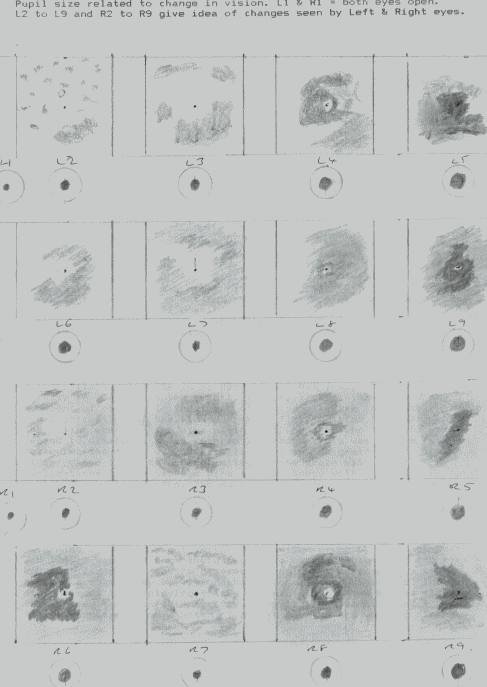
One serious effect but which is fortunately very rare was reported in the 1950s, shortly after the UK Government's report on the dangers of organophosphates by Lord Zuckerman.
A farm worker was exposed to chemicals used to treat grain and his wife reports that he returned home from work covered in a white powder. To the family's surprise a quite frightening change came over the worker whose eye colour changed from hazel to a brilliant light blue. They remained that colour for the remainder of his life but he suffered with nightmares, hallucinations, sinus trouble, bone deterioration and eventually died from a heart attack aged 62. Many will recognise the symptoms as those of poisoning but this man had served in the Army Medical Corps during the Second World War and he refused to make an official complaint - because he knew what he would face. His family and his Army and passport records would no doubt testify to the facts of this case.
Little has changed since then.
Confusion of movement - Many people who have been exposed to organophosphates find that movement triggers strange effects in their brains. Most report that moving in cars past road repair cones, barriers with regular vertical gaps or trees that similarly allow intermittent shafts of light through them cause confusion in the brain.
It has been described as a "stroboscopic effect" and that the flashing rotating warning lights on vehicles have triggered similar reactions.
Given that there are problems with image retention and colour perception, even when stationary, perhaps this is an example of how the brain is unable to cope with an overload of signals. Further evidence in support of this is that many report confusion and an inability to deal with discussions involving a number of people in a room at the same time. Faulty signalling, with tinnitus and incorrect recognition of sounds, have also been widely reported indicating that the processing system in the brain has been seriously damaged by the exposures.
Lacrimation - excessive tearing - streaming eyes. This is a known problem in those exposed to OPs, caused by the same mechanism as the profuse sweating and running nose.
Like the nose, the eye is a direct route to the brain and that probably explains the brain damage that causes the visual problems that many experience but which some simply think of as "difficulty in focusing".
The problem can be far more serious than a simply focusing issue.
Shimmering/flickering - Sometimes the vision appears to "flicker", almost like an old movie, with a similar frequency to the tremors that occur in the muscles? Perhaps this is linked to the Image Retention but there is a high level of cholinesterase receptors in the eye and this effect may well represent a problem in the signalling mechanism?
Complete loss of vision - Fortunately this does not often happen but when it does it can be quite frightening to those who experience it. Some cannot understand how there can be complete loss of one half of the vision in both eyes - until it is realised that we don't see what we think we see and the brain does actually create a picture from two halves with one half of both eyes reaching one part of the brain and the other half being processed in another area of the brain.
There is a name for it, hemianopia and it happens in stroke victims too.

These effects are known to be caused by brain disorders and so there should be no surprise that those exposed to OPs can also find that they are unable even to recognise friends they have known for years. Recognition depends on both sight and the memories linked to the key areas needed for identification.
Professor Satoshi Ishikawa in Japan studied the effects of OPs in children exposed in agricultural areas of his country. The study recognised the serious visual problems that can be triggered by OP exposure that were recognised and reviewed here as "Saku Disease"
Dated 29/4/2007.
Go to top
Return to latest updates
Return to "Your Stories";
Return to Front Page;
Return to Contents file
Return to OPs file